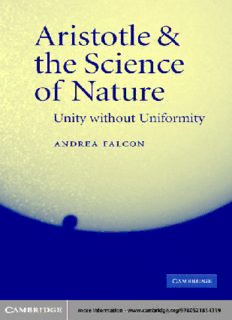
ARISTOTLE AND THE SCIENCE OF NATURE PDF
Preview ARISTOTLE AND THE SCIENCE OF NATURE
ARISTOTLE AND THE SCIENCE OF NATURE Andrea Falcon’s work is guided by the exegetical ideal of recreating themindofAristotleandhisdistinctiveconceptionofthetheoretical enterprise. In this concise exploration of the significance of the celestial world for Aristotle’s science of nature, Falcon investigates the source of discontinuity between celestial and sublunary natures and argues that the conviction that the natural world exhibits unity without uniformity is the ultimate reason for Aristotle’s claim that theheavens are madeofa special body,unique to them.This book presentsAristotleasatotallyengaged,systematicinvestigatorwhose ultimate concern was to integrate his distinct investigations into a coherentinterpretationoftheworldwelivein,allthewhilemindful ofhumanlimitationstowhatcanbeknown.FalconreadsinAristotle theambitionofanextraordinarilycuriousmindandtheconfidence thatthatambition hasbeen largelyfulfilled. andrea falcon is Assistant Professor in the Department of Philosophy at Concordia University, Montreal. He is the author of Corpiemovimenti:IlDecaelodiAristoteleelasuafortunanelmondo antico (2001). ARISTOTLE AND THE SCIENCE OF NATURE Unity without Uniformity ANDREA FALCON cambridge university press Cambridge, New York, Melbourne, Madrid, Cape Town, Singapore, São Paulo Cambridge University Press TheEdinburghBuilding,Cambridgecb22ru,UK Published in the United States of America by Cambridge University Press, New York www.cambridge.org Information on this title: www.cambridge.org/9780521854399 © Jan Paulsson 2005 Thispublicationisincopyright.Subjecttostatutoryexceptionandtotheprovisionof relevantcollectivelicensingagreements,noreproductionofanypartmaytakeplace withoutthewrittenpermissionofCambridgeUniversityPress. Firstpublishedinprintformat 2005 isbn-13 978-0-511-13258-2 eBook (Adobe Reader) isbn-10 0-511-13258-1 eBook (Adobe Reader) isbn-13 978-0-521-85439-9 hardback isbn-10 0-521-85439-3 hardback CambridgeUniversityPresshasnoresponsibilityforthepersistenceoraccuracyofurls forexternalorthird-partyinternetwebsitesreferredtointhispublication,anddoesnot guaranteethatanycontentonsuchwebsitesis,orwillremain,accurateorappropriate. In memory of Mario Mignucci, my teacher, who cared Lo duca e io per quel cammino ascoso intrammo a ritornar nel chiaro mondo; e sanza cura aver d’alcun riposo, salimmo su`, el primo e io secondo, tanto ch’i’ vidi de le cose belle che porta ’l ciel, per un pertugio tondo. E quindi uscimmo a riveder le stelle. Contents Preface page ix Acknowledgments xiii List of abbreviations and conventions xv 1 The unity, structure, and boundaries of Aristotle’s science of nature 1 2 Bodies 31 3 Motions 55 4 The limits of Aristotle’s science of nature 85 Epilogue 113 Bibliography 122 Index of names 130 Index of passages 132 General index 138 vii Preface This book develops the investigation I began in Corpi e movimenti: il De caelodiAristoteleelasuafortunanelmondoantico(Naples,2001).ThereI discussedAristotle’sreasonsfortheviewthatthecelestialbodiesaremade of a special body which naturally performs circular motion and is differ- ent from, and not reducible to, earth, water, air, and fire. I have also shownthatveryfewinantiquity,evenwithintheschoolofAristotle,were prepared to accept this doctrine, though many, if not most of them, shared Aristotle’s view that the celestial world is a special and somehow distinctregionofthenaturalworld.Thisbookincorporatesmaterialfrom the Italian one but presents it in the light of a new project. By studying the reception of the view that the heavens are made of a special body, I have come to appreciate not only how unusual Aristotle’s conception of thenatural world is;I have also cometo understand how this conception may have affected the way Aristotle conceives of the science of nature. This book is an attempt to explore the significance of the study of the celestialbodiesforAristotle’sprojectofinvestigationofthenaturalworld. WhileAristotleargues,againsthispredecessors,thatthecelestialworld is radically different from the sublunary world, he is not envisioning two disconnected, or only loosely connected, worlds. On the contrary, Aristotleconceivesofthenaturalworldasonedepartmentofrealitywitha sufficient unity to be the object of a single science. I show, however, that for Aristotle this world exhibits unity without uniformity. More specifi- cally, there are features of the celestial world that outrun the explanatory resources developed by Aristotle for the study of the sublunary world. According to Aristotle, there is an important discontinuity between the celestial and the sublunary worlds, and this discontinuity leads him to a further conclusion: that the celestial bodies are made of a special body, unique to them. ix
Description: